 W
WThe Acrotretida are a group (order) of sessile, suspension-feeding brachiopods known from the Cambrian period and surviving until the present day. Their shell has a round outline, and is usually phosphatic in recent specimens.
 W
WAtrypa is a genus of brachiopod with shells round to short egg-shaped, covered with many fine radial ridges, that split further out and growthlines perpendicular to the costae and 2-3 times wider spaced. The pedunculate valve is a little convex, but tends to level out or even become slightly concave toward the anterior margin. The brachial valve is highly convex. There is no interarea in either valve. Atrypa was a cosmopolitan and occurred from the late Lower Silurian (Telychian) to the early Upper Devonian (Frasnian). Other sources expand the range from the Late Ordovician to Carboniferous, approximately from 449 to 336 Ma. A proposed new species, A. harrisi, was found in the trilobite-rich Floresta Formation in Boyacá, Colombia.
 W
WAtrypa reticularis is an extinct species of brachiopods. The fossils are present from the base of Rhuddanian up to the top of Lower Frasnian.
 W
WChonetes is an extinct genus of brachiopods. It ranged from the Late Ordovician to the Middle Jurassic.
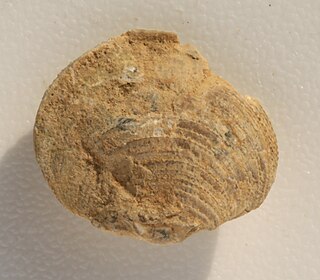 W
WCleiothyridina is an extinct genus of brachiopods.
 W
WComposita is an extinct brachiopod genus that lived from the Late Devonian to the Late Permian. Composita had a cosmopolitan global distribution, having lived on every continent except Antarctica. Composita had a smooth shell with a more or less distinct fold and sulcus and a round opening for the pedicle on the pedicle valve. Composita is included in the family Athyrididae and placed in the subfamily Spirigerellinae.
 W
WCrania is an extinct genus of brachiopods that lived during the Upper Cretaceous.
 W
WCraniata is a class of brachiopods originating in the Cambrian period and still extant today. They have calcitic inarticulated shells that are subcircular in outline. This class of brachiopods has an unsupported lophophore and is always attached to a hard substrate in the fossil record. This hard substrate is usually another brachiopod. The plicae from the host brachiopod will then appear within the shell of the craniata.
 W
WThe Craniidae are a family of brachiopods, commonly known as lamp shells. Although it belongs to a subdivision called the inarticulata which have shells where the mineral content consist of calcium phosphate, the Craniidae have shells that consist of calcium carbonate. Other special characteristics of this family are that no outgrowths are developed to form a hinge between both valves, nor is there any support for the lophophore. As adults, craniids either lived free on the ocean floor or, more commonly, were attached to a hard object with all or part of the ventral valve. All other brachiopods are supposed to have a stalk or pedicle, at least as an adolescent, but in craniids a pedicle is not known from any development stage.
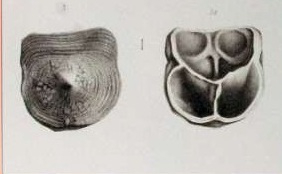 W
WCraniscus is a genus of small brachiopods. The shell is approximately round to square with one side rounded. The ventral valve is approximately flat and attached to the underground by the entire surface. The outside of the dorsal valve is more or less conical, the inside is divided by three ridges that join in the center.
 W
WCyrtospirifer is an extinct genus of brachiopods. The fossils are present in the Middle and Upper Devonian.
 W
WCyrtospirifer verneuili, also called Spirifer verneuili, is an extinct species of brachiopods. The fossils are present in the Upper Devonian.
 W
WCyrtospiriferidae is an extinct family of Brachiopods.
 W
WDiscinidae is a family in the brachiopod superfamily Discinoidea. Unlike most brachiopods, which have uniformly calcitic or phosphatic shells, modern-day discinids incorporate tablets of silica into their valves. These are covered with vesicles into which the siliceous tablets are cemented, much like a closely packed mosaic, and held together with apatite. These vesicles eventually degrade, but nevertheless still leave an imprint on the shell itself. It has been suggested that this siliceous biomineralisation might also have occurred amongst some of the earliest Paleozoic brachiopods because similar patterns of shell imprints have been observed amongst them too.
 W
WDiscinisca is a genus of brachiopods with fossils dating back from the Early Devonian to the Pliocene of Africa, Europe, North America, and New Zealand.
 W
WGwynia is a genus of very small to minute brachiopods.
 W
WGwynia capsula is a very small to minute brachiopod, currently known from the east Atlantic, but which occurred during the Pleistocene in what is now Norway. It has a translucent, whitish, purse-shaped shell with relatively large, wide-spaced pits. It lives attached to stones or shells (fragments) in between large grains of sand. Like in all brachiopods, it filters food particles, chiefly diatoms and dinoflagellates. Gwynia capsula harbors a small number of larvae inside a brood pouch, but it has separate sexes, unlike also very small and pouch brooding Argyrotheca and Joania, which are hermaphrodite.
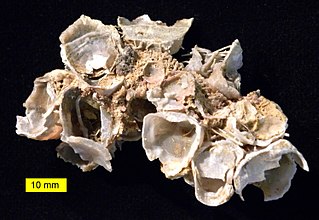 W
WHercosestria is an extinct genus of brachiopods from the Lower and Middle Permian. They were important reef-forming organisms because of their conical shapes, attaching spines, and gregarious habits. It is related to Richthofenia. Species of the genus have been found in Texas and Guatemala.
 W
WIsjuminella is a species of extinct, brachiopod, a marine rhynchonellate lampshell in the family Tetrarhynchiidae.
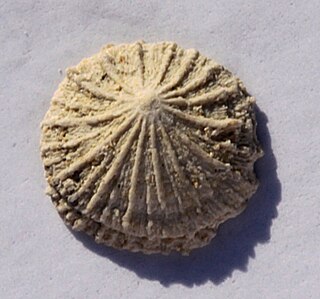 W
WIsocrania is an extinct genus of brachiopods found during the Upper Cretaceous. Early representatives were attached to the underground, but later species are presumed to be free living at an increasingly earlier age. This was probably an adaptation to the increasing very thick and fine sedimentation during the latest Cretaceous.
 W
WKallirhynchia is an extinct genus of brachiopods found in Jurassic strata in Europe, North Africa, the Middle East, India and Uzbekistan. It was a stationary epifaunal suspension feeder.
 W
WKingena is an extinct genus of primarily Cretaceous-aged brachiopods whose fossils are found in marine strata of Antarctica, Europe, North America, and New Zealand. Early Paleocene-aged fossils from Denmark represent the youngest species.
 W
WKutoringates are early rhynchonelliform brachiopods.
 W
WLeptaena is an extinct genus of mid-sized brachiopod that existes from the Dariwilian epoch to the Emsian epoch, though some specimens have been found in strata as late in age as the Tournasian epoch. Like some other Strophomenids, Lepteana were epifaunal, meaning they lived on top of the seafloor, not buried within it, and were suspension feeders.
 W
WLingulella is a genus of phosphatic-shelled brachiopod. It is known from the Middle Cambrian Burgess Shale (Canada) to the Upper Ordovician Bromide Formation in North America. 346 specimens of Lingulella are known from the Greater Phyllopod bed, where they comprise 0.66% of the community.
 W
WLingulida is an order of brachiopods.
 W
WLinguliformea is a subphylum of inarticulate brachiopods. These were the earliest of brachiopods, ranging from the Cambrian into the Holocene. They rapidly diversified during the Cambrian into the Ordovician, but most families became extinct by the end of the Devonian.
 W
WLinguloidea is a superfamily of brachiopods.
 W
WMicromitra is a genus of brachiopods known from the Middle Cambrian Burgess Shale. 160 specimens of Micromitra are known from the Greater Phyllopod bed, where they comprise 0.3% of the community.
 W
WObolella is a genus of Cambrian brachiopods.
 W
WObolidae is a family of extinct brachiopods.
 W
WParaspirifer is a genus of large brachiopods that lived during the late Lower and Middle Devonian in what now are Germany, Spain, Morocco and the United States.
 W
WPentamerus is a prehistoric genus of brachiopods that lived from the Silurian to the Middle Devonian in Asia, Europe, and North America.
 W
WPlatystrophia is an extinct genus of brachiopods that lived from the Ordovician to the Silurian in Asia, Europe, North America, and South America. It has a prominent sulcus and fold. It usually lived in marine lime mud and sands.
 W
WPrionorhynchiidae is an extinct family of brachiopods belonging to the order Rhynchonellida.
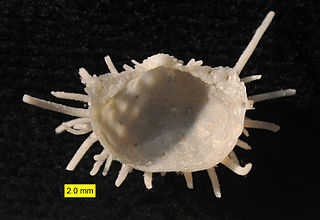 W
WProductida is an extinct order of brachiopods in the extinct class Strophomenata.
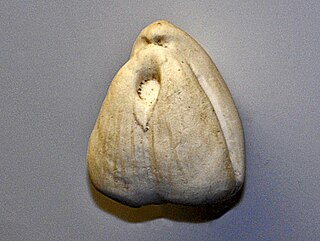 W
WPygope is an extinct genus of brachiopods belonging to the family Pygopidae. These brachiopods lived in open sea from the Jurassic Period, Kimmeridgian age up to Cretaceous Period, Barremian age. Some of the species are characterised by a smaller or larger perforation through the entire shell in older specimens, while others just have a depression somewhere on the midline. Younger specimens of the perforated species develop a heart-shape and subsequently both extensions merge, thus encircling a central passage which is in fact entirely outside the shell.
 W
WPygopidae is an extinct family of Brachiopods.
 W
WRafinesquina is an extinct genus of large brachiopod that existed from the Darriwilian to the Ludlow epoch.
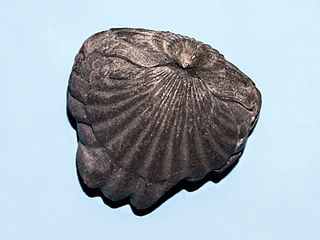 W
WRhynchonella is an extinct genus of brachiopod found in Silurian to Eocene strata worldwide. It was a stationary epifaunal suspension feeder.
 W
WSphenorhynchia is an extinct genus of brachiopods belonging to the family Prionorhynchiidae.
 W
WSphenorhynchia plicatella is an extinct species of brachiopods belonging to the family Prionorhynchiidae.
 W
WSpirifer is a genus of marine brachiopods belonging to the order Spiriferida and family Spiriferidae. Species belonging to the genus lived from the Middle Ordovician (Sandbian) through to the Middle Triassic (Carnian) with a global distribution. They were stationary epifaunal suspension feeders.
 W
WSpiriferina is an extinct genus of brachiopods that lived from the Late Silurian to the Middle Jurassic in Asia, Europe, North America, South America, and New Zealand.
 W
WStringocephalus is an extinct genus of large brachiopods; between 388.1 to 376.1 million years old they are usually found as fossils in Devonian marine rocks. Several forms of the genus are known; they may be found in western North America, northern Europe, Asia and the Canning Basin of Western Australia. Several different types are known; they share a well-developed, curved structure shaped like a beak. Some of the largest specimens discovered to date have been found in China.
 W
WStrophomenata is an extinct class of brachiopods in the subphylum Rhynchonelliformea.
 W
WTerebratellidae is an extant family of brachiopods with a fossil record dating back to the Jurassic.
 W
WTerebratellidina is one of two existing suborders of Terebratulid brachiopods, the other being Terebratulidina.
 W
WTerebratulidae is a family of brachiopods with a fossil record dating back to the Late Devonian. It is subdivided into 11 subfamilies.
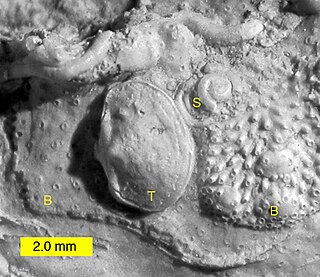 W
WThecideida is an order of cryptic articulate brachiopods characterized by their small size and habit of cementing their ventral valves to hard substrates such as shells, rocks and carbonate hardgrounds. Thecideides first appear in the Triassic and are common today.
 W
WUncites is an extinct genus of brachiopods in the family Uncitidae. This genus includes spire-bearing brachiopod with a rostrate ventral valve. A typical species is Uncites gryphus from the Middle Devonian in Germany.
 W
WUncitidae is an extinct family of brachiopods.
 W
WVictorithyris is a genus of brachiopod from southern Australia. It lived during the Eocene to Miocene period.